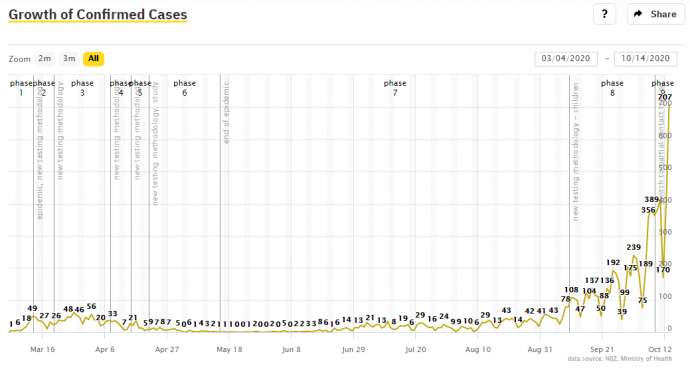STA, 14 October 2020 - A total of 707 new Sars-CoV-2 cases were confirmed in Slovenia on Tuesday, almost a doubling of Monday's figure and a new record by far, which comes on 4,902 tests conducted, a new high as well as the positivity rate hit a record 14.4%, government data show.
"Today's data show the situation is getting increasingly serious (...) The situation calls for action, measures taken so far have not done enough to prevent the spread of the virus," government spokesman Jelko Kacin told the Covid-19 briefing as the government is meeting in the afternoon to adopt new restrictions.According to him, Slovenia's incidence rate, a key EU-wide indicator that shows the number of infections per 100,000 residents in the past 14 days, has increased to 202.75 from 178.91 the previous day.
Covid-19 claimed two more lives, increasing Slovenia's death toll related to the disease to 175.
This was as the number of Covid-19 patients in hospitals increased by 30 to 210 despite 17 being discharged. As many as 35 patients, four more than the day before, now require intensive treatment.
Data from tracker site Covid-19.sledilnik.org shows that Slovenia has currently 4,248 active infections out of a total of 9,938 coronavirus cases confirmed so far.
Kacin said the outbreak was spreading at care homes with several aged-care facilities across the country reporting new infections.
Data from the tracker site indicate that a total of 15 new infections were recorded among care home residents and another 4 among staff, as well as 45 new infections among healthcare staff.
Matjaž Jereb, head of the intensive care unit at the Department of Infectious Diseases at the UKC Ljubljana hospital, said the estimate was that one out of every 150 Slovenians was infected.
He warned that hospitals were running out of intensive care beds, and in particular qualified staff to care for the critically ill.
"Ten percent of Covid-19 require hospitalisation and 20% of those intensive care," he said, projecting that out of 700 plus cases confirmed yesterday 70 will need hospital treatment and 15 of them intensive care in ten days.
He described intensive care units as a "bottleneck", considering those patients require intensive treatment for two weeks and longer.
"We have 16 critically ill at our [Covid-19] unit in Ljubljana who require mechanical support and ventilators (...) no one is immune, we have a 42-year-old patient without serious underlying conditions," said Jereb.
Asked about potential measures, including regional lockdowns, Kacin said lockdowns would depend on the region's incidence. "Seven regions are now red and three are still yellow," he said as an indication of what the the government may be expected to decide.
The worst affected region at the moment is now Gorenjska in the north-west with 266 infections per 100,000 residents over the past fortnight.
Six more are above the 140 limit, one of the threshold factors between phase orange and red, which triggers the declaration of epidemic and harshest restrictions.
Marija Magajna, acting director of the Healthcare Inspectorate, said that a decree has been drawn up to suspend some of the health services, announcing that preventive activities would be suspended first, but with a series of exceptions such as those concerning children and youth and cancer screening programmes.
Suspension or delay of non-urgent hospital services would depend on how many beds and other capacities need to be adapted to take Covid-19 patients.
Measures have also been drawn up to reduce the scope for coronavirus transmissions inside health institutions with Magajna indicating that the providers would need to monitor the health condition of their employees.
Covid-19 tracker site data show that 100 of the latest cases were confirmed in Ljubljana, which has now 698 active infections for a per capita infection rate of 0.237.
A further 38 cases were recorded in Kranj in the north-west, which has 173 active infections for an infection rate of 0.305%. But several smaller municipalities have much higher rates, the hardest-hit remaining Črna na Koroškem with 0.853%.
The latest statistics on coronavirus and Slovenia, and the latest police news on red, green and yellow list countries. All our stories on coronavirus and Slovenia. Can I transit Slovenia? Find out from the police...






